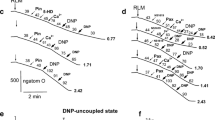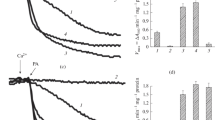Abstract
At low Ca2+ concentrations the pore of the inner mitochondrial membrane can open in substates with lower permeability (Hunter, D. R., and Haworth, R. A. (1979) Arch. Biochem. Biophys., 195, 468-477). Recently, we showed that Ca2+ loading of mitochondria augments the cyclosporin A-dependent decrease in transmembrane potential (ΔΨ) across the inner mitochondrial membrane caused by 10 μM myristic acid but does not affect the stimulation of respiration by this fatty acid. We have proposed that in our experiments the pore opened in a substate with lower permeability rather than in the “classic” state (Bodrova, M. E., et al. (2000) IUBMB Life, 50, 189-194). Here we show that under conditions lowering the probability of “classic pore” opening in Ca2+-loaded mitochondria myristic acid induces the cyclosporin A-sensitive ΔΨ decrease and mitochondrial swelling more effectively than uncoupler SF6847 does, though their protonophoric activities are equal. In the absence of Pi and presence of succinate and rotenone (with or without glutamate) cyclosporin A either reversed or only stopped ΔΨ decrease induced by 5 μM myristic acid and 5 μM Ca2+. In the last case nigericin, when added after cyclosporin A, reversed the ΔΨ decrease, and the following addition of EGTA produced only a weak (if any) ΔΨ increase. In Pi-containing medium (in the presence of glutamate and malate) cyclosporin A reversed the ΔΨ decrease. These data show that the cyclosporin A-sensitive decrease in ΔΨ by low concentrations of fatty acids and Ca2+ cannot be explained by specific uncoupling effect of fatty acid. We propose that: 1) low concentrations of Ca2+ and fatty acid induce the pore opening in a substate with a selective cation permeability, and the cyclosporin A-sensitive ΔΨ decrease results from a conversion of ΔΨ to pH gradient due to the electrogenic cation transport in mitochondria; 2) the ADP/ATP-antiporter is involved in this process; 3) higher efficiency of fatty acid compared to SF6847 in the Ca2+-dependent pore opening seems to be due to its interaction with the nucleotide-binding site of the ADP/ATP-antiporter and higher affinity of fatty acids to cations.
Similar content being viewed by others
REFERENCES
Hunter, D. R., Haworth, R. A., and Southard, J. H. (1976) J. Biol. Chem., 251, 5069-5077.
Hunter, D. R., and Haworth, R. A. (1979) Arch. Biochem. Biophys., 195, 453-459.
Haworth, R. A., and Hunter, D. R. (1979) Arch. Biochem. Biophys., 195, 460-467.
Hunter, D. R., and Haworth, R. A. (1979) Arch. Biochem. Biophys., 195, 468-477.
Ichas, F., and Mazat, J.-P. (1998) Biochim. Biophys. Acta, 1366, 33-50.
Furneier, N., and Ducket, G. (1987) J. Bioenerg. Biomembr., 19, 297-303.
Andreev, A. Yu., Dedukhova, V. I., and Mokhova, E. N. (1990) Biol. Membr. (Moscow), 7, 480-486.
Brustovetsky, N. N., Egorova, M. V., Gnutov, D. Yu., Mokhova, E. N., and Skulachev, V. P. (1992) FEBS Lett., 315, 233-236.
Petronilli, V., Cola, C., Massari, S., Colonna, R., and Bernardi, P. (1993) J. Biol. Chem., 268, 21939-21945.
Broekemeier, K. M., and Pfeiffer, D. R. (1995) Biochemistry, 34, 16440-16449.
Schonfeld, P., and Bohnensack, R. (1997) FEBS Lett., 420, 167-170.
Wieckowski, M. R., and Wojtczak, L. (1998) FEBS Lett., 423, 339-342.
Chavez, E., Zazueta, C., and Garcia, N. (1999) FEBS Lett., 445, 189-191.
Le Quo, K., and Le Quoc, D. (1988) Arch. Biochem. Biophys., 265, 249-257.
Dierks, T., Salentin, A., Heberger, C., and Kramer, R. (1990) Biochim. Biophys. Acta, 1028, 268-280.
Halestrap, A. P., and Davidson, A. M. (1990) Biochem. J., 268, 153-160.
Halestrap, A. P., Woodfield, K.-Y., and Connern, C. P. (1997) J. Biol. Chem., 272, 3346-3354.
Crompton, M. (1999) Biochem. J., 341, 233-249.
Andreyev, A. Yu., Bondareva, T. O., Dedukhova, V. I., Mokhova, E. N., Skulachev, V. P., Tsofina, L. M., Volkov, N. I., and Vygodina, T. V. (1989) Eur. J. Biochem., 182, 585-592.
Relay, W. W., and Pfeiffer, D. R. (1985) J. Biol. Chem., 260, 12416-12425.
Davidson, A. M., and Halestrap, A. P. (1990) Biochem. J., 268, 147-152.
Gainutdinov, M. Kh., Konov, V. V., Ishmukhamedov, R. N., Zakharova, T. N., Khalilova, M. A., and Safarov, K. S. (1992) Biokhimiya, 57, 1618-1626.
Novgorodov, S. A., and Gudz, T. I. (1996) J. Bioenerg. Biomembr., 28, 139-145.
Kuschnareva, Yu. E., and Sokolova, P. M. (2000) Arch. Biochem. Biophys., 376, 377-388.
Bodrova, M. E., Dedukhova, V. I., Samartsev, V. N., and Mokhova, E. N. (2000) IUBMB Life, 50, 189-194.
Akerman, K. E. O., and Wikstrom, M. K. F. (1976) FEBS Lett., 68, 191-197.
Scarpa, A. (1979) Meth. Enzymol., 56, 301-338.
Nicholls, D., and Akerman, K. (1982) Biochim. Biophys. Acta, 683, 57-88.
Wojtczak, L. (1974) FEBS Lett., 44, 25-30.
Schonfeld, P., Schluter, T., Schuttig, R., and Bohnensack, R. (2001) FEBS Lett., 491, 45-49.
Sharpe, M. A., Cooper, C. E., and Wrigglesworth, J. M. (1994) J. Membr. Biol., 141, 21-28.
Chernyak, B. V. (1997) Biosci. Rep., 17, 293-302.
Bernardi, P. (1992) J. Biol. Chem., 267, 8834-8839.
Agureev, A. P., and Mokhova, E. N. (1979) in Reactions of Living Systems and the State of Energy Metabolism (Kondrashova, M. N., ed.) [in Russian], Institute of Biological Physics, Pushchino-on-Oka, pp. 27-51.
Kargopolov, A. V., and Yaguzhinskii, L. S. (1978) Biokhimiya, 43, 2150-2153.
Skulachev, V. P. (1991) FEBS Lett., 294, 158-162.
Starkov, A. A., Bloch, D. A., Chernyak, B. V., Dedukhova, V. I., Mansurova, S. E., Severina, I. I., Simonian, R. A., Vigodina, T. V., and Skulachev, V. P. (1997) Biochim. Biophys. Acta, 1318, 159-172.
Skulachev, V. P. (1988) Membrane Bioenergetics, Springer, Berlin.
Author information
Authors and Affiliations
Rights and permissions
About this article
Cite this article
Bodrova, M.E., Brailovskaya, I.V., Efron, G.I. et al. Cyclosporin A-Sensitive Decrease in the Transmembrane Potential across the Inner Membrane of Liver Mitochondria Induced by Low Concentrations of Fatty Acids and Ca2+ . Biochemistry (Moscow) 68, 391–398 (2003). https://doi.org/10.1023/A:1023691628110
Issue Date:
DOI: https://doi.org/10.1023/A:1023691628110




